Dachstein-Rieseneishöhle
The Dachstein Giant Ice Cave
Useful Information
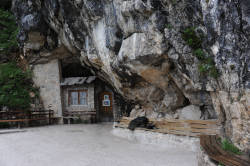
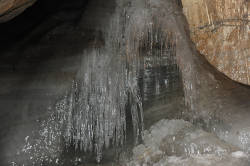

| Location: |
Obertraun, Salzkammergut.
A1 (E55) exit 234 Gmunden, follow B145 through Gmunden, Bad Ischgl, and Bad Goisern. Behind Bad Goisern turn right onto 166 to Gosaumühle, turn left along Hallstatt lake through Hallstadt to Obertraun. Take Dachstein Cable Car. 20 minutes walk (700 m walk, 70 m elevation gain) from Schönberg Alp, 1st station. (47.5349012, 13.7187077) |
| Open: |
MAY to JUN daily 8:40-15:30. JUL to AUG daily 8:40-16:30. SEP to OCT daily 8:40-15:30. [2025] |
| Fee: |
Rieseneishöhle + Mammuthöhle + Cable Car: Adults EUR 48,70, Children (15-17) EUR 43,80, Children (6-14) EUR 26,80, Senior (65+) EUR 46,30. Groups (20+): Adults EUR 46,40, Children (15-17) EUR 40, Children (6-14) EUR 25. [2025] |
| Classification: |
 Karst Cave Karst Cave
 ice cave. ice cave.
|
| Light: |
 LED LED
 Coloured Light Coloured Light
 Son et Lumière Son et Lumière
|
| Dimension: | L=2,700 m, VR=70 m, A=1,455 m asl, T=-1 °C. |
| Guided tours: |
L=700 m, VR=80 m, D=50 min,





V=120,000/a [2000] |
| Photography: | allowed |
| Accessibility: | no |
| Bibliography: |
Ing Hermann Bock et al. (1913):
Höhlen im Dachstein und ihre Bedeutung für die Geologie, Karsthydrographie und die Theorien über die Entstehung des Eises,
Dem Andenken weiland Prof Friedrich Simonys.
151 pp some fine sepia photos, illus, maps etc. HB

|
| Address: |
Dachstein Tourismus AG, Customer Service Team, Winkl 34, 4831 Obertraun am Hallstättersee, Tel: +43-50-140.
E-mail: |
| As far as we know this information was accurate when it was published (see years in brackets), but may have changed since then. Please check rates and details directly with the companies in question if you need more recent info. |
|
History
| 1897 | According to a legend, the Obertrauner Peter Gamsjäger discovered the ice cave in search of lost livestock. |
| 17-JUL-1910 | discovered by Hanna and Hermann Bock and Georg Lahner. |
| 1912 | development and opening of the show cave. |
| 1928 | electric lighting installed. |
| 1951 | first section of the cabble car built, nuber of visitors increases dramatically. |
| 1952 | New entrance opened to the public. |
| 1973 | declared a Naturdenkmal (Natural Monument). |
| 2007 | start of renovation of all three caves by the Kunstuniversität Linz, Institut für Raum- und Designstrategie. |
| MAY-2008 | renovation completed. |
Description
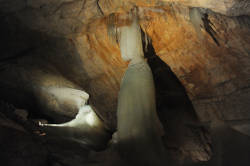
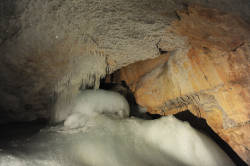
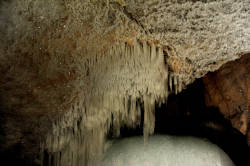
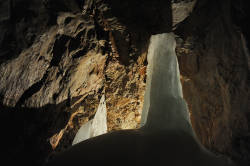
The first chambers of the cave are devoid of ice but still very cold with no speleothems. The floor is covered with huge limestone blocks which have fallen from the roof, some as big as houses. Soon, one enters King Arthur’s Dome a one of the largest chambers in the cave, 120 m long, 50 m wide and 20 m high.
Next the passage ascends into Parsifal’s Dome with a massive ice stalagmite called Gralsburg or the Castle of the Holy Grail. After this the ice accompanies the visitor for the rest of the tour. The ice formations are really magnificent, and they are set in such vast surroundings. Huge pillars reach from floor to ceiling, and the whole floor is one shining sheet of green ice. There are wonderful flower like crystals on the roof which occasionally fall with a softy tinkling sound onto the ice floor beneath. In Tristan’s Dome the descent to the Large Ice Chapel represents the climax of the trip. The floors, ceiling and walls of this room are all covered in a dazzling display of sheets of ice which create an enchanting fairy tale scene.
From here it is only a short distance to the second entrance and the end of the trip.
Text by Tony Oldham (2002). A visit in 1965. With kind permission.
The Dachstein-Rieseneishöhle (Dachstein Giant Ice Cave) is famous for large caverns filled with ice. The Rieseneishöhle is one of the dynamic ice caves, also known as caves with dynamic ventilation. These cave systems have entrances at different heights. When the outside temperature is higher in summer, cold cave air, which is heavier, flows out of the lower entrance and warmer air is drawn in at the top. When the outside temperature is lower in winter, the warmer, lighter cave air flows out of the upper entrance and the cold air is drawn in at the bottom. In both cases, a convection current develops. The ice therefore grows in winter and about the same amount melts over the course of the year. This balance is quite fragile, and so in the long term there is a continuous increase or decrease in ice. It can be assumed that the cave has frozen and de-iced several times during the post-glacial climate fluctuations. Apparently, 500 years ago, during a warm period in the Middle Ages, the cave ice had completely melted. When the climate became colder afterwards, the ice grew continuously.
If the ice had continued to grow, the cave would very soon have been filled with ice to the ceiling. However, global warming has been in effect for several decades now, and the ice is currently in continuous decline. The show cave administration, for whom the ice is of course a sales factor has been taking countermeasures since the 1990s. The convection current was interrupted by the gates that close the cave entrances and can also be controlled through the gates. The upper entrance was fitted with electrically operated flaps, and these were opened on cold winter nights to let cold air into the cave. This lowered the temperature considerably and significantly reduced the melting of the ice. However, even this no longer seems enough: since 2002, the ice has been receding at an average rate of 6 cm per year. One of the problems is that the cave probably has many crevices and fissures with a connection to the surface, which cannot be travelled through by people, but offer alternative routes for the cave air. If you want to see the ice cave with its ice, you shouldn’t wait too long.
The above description of a cave tour by Tony Oldham is still correct today. Over the last few decades, however, the tour has been spiced up with various installations. It probably started with a work of sound art by Hubert von Goisern. He is a well-known local musician who combines modern rock with traditional Austrian folk music. There are now works of art, coloured light and various light and sound installations.
If you visit the cave, remember to bring warm clothing! Despite the above-mentioned warming, the temperature in the cave is -2 °C. It takes about 20 minutes to walk from the middle station to the cave entrance. The guided tour starts at the cave entrance, so please allow for the cable car ride and the climb. There are a total of two show caves here, the Giant Ice Cave and the Mammoth Cave, as well as the cave museum on the Schönbergalm. There is also the trip to the summit of the Krippenstein with its viewing platforms. To see everything, you should plan a whole day; to see both caves, you should leave by 2 p.m. at the latest, and to see one cave by 3.30 p.m. at the latest. As there are so many options, we have limited ourselves to giving the opening times and entrance fees for the actual cave visit only. For more details and online booking please go to the official website. Please note the following catch 22: tickets for the cable car ride and cave are sold at the valley station of the cable car, but you must register for the guided tour at the Schönbergalm afterwards.
- See also
 Caves With a View
Caves With a View Search DuckDuckGo for "Dachstein Rieseneishöhle"
Search DuckDuckGo for "Dachstein Rieseneishöhle" Google Earth Placemark
Google Earth Placemark OpenStreetMap
OpenStreetMap Dachstein-Rieseneishöhle - Wikipedia (
Dachstein-Rieseneishöhle - Wikipedia ( )
) Dachstein Giant Ice Cave, official website (visited: 16-APR-2020)
Dachstein Giant Ice Cave, official website (visited: 16-APR-2020) Dachstein-Eishöhlen
Dachstein-Eishöhlen  (visited: 16-APR-2020)
(visited: 16-APR-2020) Dachstein Giant Ice Cave (visited: 16-APR-2020)
Dachstein Giant Ice Cave (visited: 16-APR-2020)
 Index
Index Hierarchical
Hierarchical Countries
Countries Maps
Maps